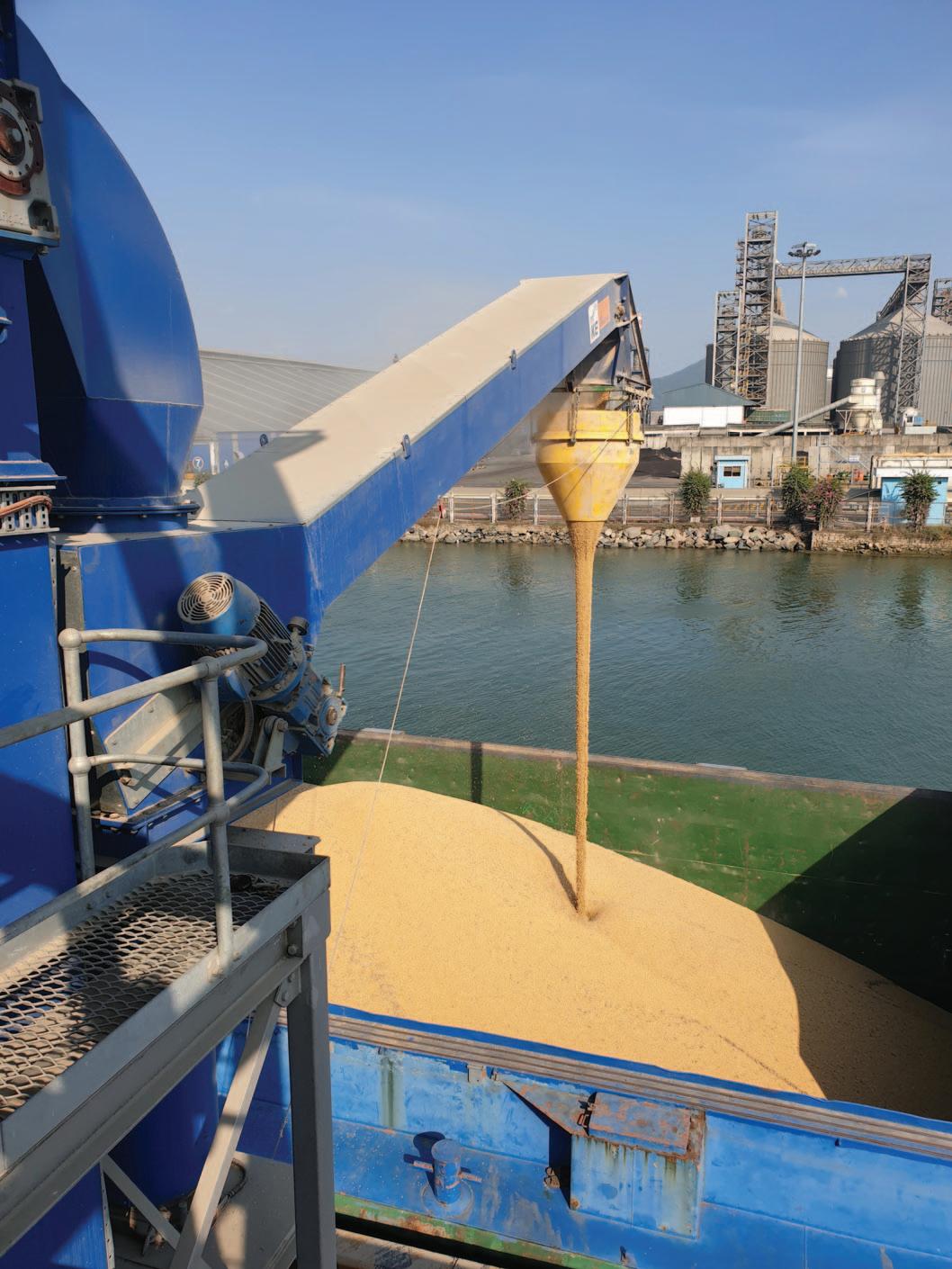
5 minute read
Riga Universal Terminals quadruples biomass loading productivity
With growth in environmental awareness and increasing demand for renewable energy sources, growth in biomass exports have increased. As a result Riga Universal Terminals (RUT) began handling biomass pellets and wood chips, but was looking for innovative ways to cope with the demand while still being cost competitive for its clients.
After extensive research, RUT’s management were steered towards a system called Containerized Bulk Handling (CBH). This particular system allows the commodity to be directly loaded into containers and tipped into the ships hold with rotating spreader RAM Revolver® attached to a Liebherr mobile harbour crane.
RUT’S EXPANSION Riga universal terminal, located just outside the beautiful city centre of Riga in Latvia was formed in 2001 and rapidly developed to become one of the top terminals in the port of Riga.
In 2013 international operator Portek Group from Singapore took note of this success and acquired RUT. The innovative management team has grown the business from traditional sources, adding different kinds of cargo.
The multipurpose port can handle containers, breakbulk, timber and various types of bulk materials.
Due to a rising demand for renewable energy sources, a few years ago RUT started handling sunflower pellets, wood pellets and wood chips. Being biomass products, wood pellets and chips are quickly becoming a valuable commodity and is in high demand as a reliable and renewable energy source.
The increasing demand meant that RUT had to look at more efficient high capacity loading systems to continue growth.
CBH— GOOD OPTION FOR MATERIAL HANDLING When considering the different options available, RUT had thought about buying a new material handler in the region of €1.3 million, as well as the possibility of having to sell one of its existing Liebherr mobile harbour cranes in order to buy a bigger and much more expensive crane.
With the support of Liebherr service partner Alfis Ltd. and the sales agency Intersafe Marine AB, RUT soon got the recommendation for the RAM Revolver® .
Containerized Bulk Handling with the revolver allows for high capacity loading of up to 45 tonnes per cycle. Utilizing the existing Liebherr MHC and the skilled operators; RUT projected 30 cycles per hour.
This meant that for a small investment the RUT could increase loading rates making the terminal more profitable with higher annual tonnage for a small investment in crane attachment.
OPERATION The RAM Revolver® and purpose-built high capacity containers were delivered in January and they made a difference straight away.
While loading vessels with wood chips, RUT compared the work of a material handler with the work of a RAM Revolver® by measuring the time it takes to load the vessels with each machine. They found out that the material handler had a maximum capacity of handling 200 tons/hour, while the RAM Revolver® reached of 800 tons/hour on the first usage which can only increase.
Says RAM Spreaders Head of Sales & Marketing Cameron Hay, “Being the first Revolver in Europe, the CBH system is world’s best practice for environment; and we can see in Riga that it increases productivity as well”.
FACTS ABOUT RAM REVOLVER® Loading bulk with RAM Revolver® is revolutionary because of the reduction in material loss and pollution.
The system first uses containers which can be enclosed with a lid to stop any material loss.
Secondly the system adds little energy to material when tipping gently at the bottom of the hatch where there is very little dust generated.
RUT is very proud and happy of being able to operate with this innovative kind of machinery; and are looking forward to welcoming guests from other ports and companies to show them the fast and easy operation of its new RAM Revolver® .
Even though the RAM Revolver® is widely used in bulk handling in Australia and South America, the one in Riga is now the very first of its kind working in Europe.
Splicing material selection
The weakest point of any rubber conveyor belt is the splice joint. You can fit the best quality belt in the world but if the splice joints are not strong and durable enough, then failure can be catastrophic and extremely dangerous. To get the best results, it is essential that the splicing material rubber has very similar physical properties and characteristics compared to the rubber used to make the belt itself. This means that the splicing materials should be of the same type, or ‘grade’, as the belt itself, such as abrasion resistant or oil resistant for example.
However, because all the individual components such as cover rubber, skim (inter-ply) rubber and the rubber solution, have very specific properties and curing characteristics to do the job they are designed to do, it is important that their intended application areas is respected in order to achieve the best results.
Although all splicing materials must be a compatible match to bond with each other, they should also match with the belt. The more specialized the belt grade, such as fire resistant for example, the more critical it becomes to match the splicing materials to it. It is also important that the splicing material rubber is not simply ‘generic’ rather than having been specifically constructed to achieve the strongest and most efficient bond so that good adhesions on both carcass and the transition to the base belt are obtained. These objectives are usually best achieved by using splicing kits and splicing materials supplied by the manufacturer of the belt.
SAFE TO HANDLE Nobody in the industry works so physically close to rubber conveyor belts as splicing technicians. It is therefore extremely important to ensure that the splicing materials being used are compliant with European safety and environmental REACH regulation. These regulations protect human health and the environment by restricting or banning chemicals that pose hazards including those chemicals or substances that may have category 2 carcinogenic classifications. Manufacturers based outside of Europe are not subject to these regulations. As far as we are aware, this level of compliance is unique to Dunlop and should certainly be a very important factor for anyone responsible for the welfare of those who use splicing materials in their daily work.
Dunlop representatives can provide more information on the company’s wide range of splicing materials including splicing kits and pre-formed kits for steel cord belting. Dunlop Conveyor Belting
CONVEYING ADVICE


















